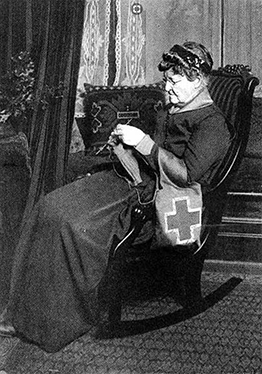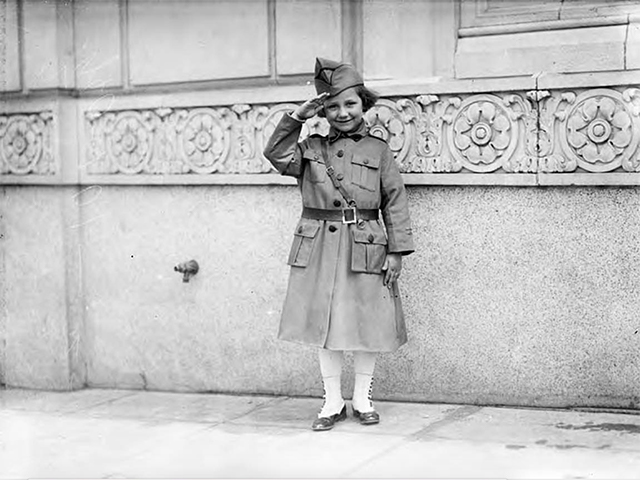Homefront
The fervor of the domestic front, mobilized by a massive propaganda effort headed by the Committee on Public Information, had three major battlegrounds: food, funding, and service.
"The women should stand behind the men who are shouldering the guns. There are thousands of Seattle women who have become "Hooverized," so to speak, and they feel much better for it… It is urgently demanded that waste be eliminated. This is an easy manner if one will only try. We follow the recommendations set down by Mr. Hoover and the food administration and find that we are able to do away with waste virtually altogether."
The U.S. Food Administration headed by Herbert Hoover encouraged households with its slogan, "Food will win the war." Though formal rationing was not instituted during World War I, housewives were encouraged to "self-sacrifice" voluntarily by cutting waste and adopting meatless Mondays, wheatless Wednesdays, and even porkless Thursdays and Sundays. Children too were told to "clean their plates" whilst thinking "of the starving orphans" of Europe. Liberty Bonds and Thrift Stamps helped to fund the war. Bonds were hawked by celebrities such as Charlie Chaplin and Al Jolson, by scout troops and by librarians. For example, 4.5 million Liberty Loan reminder cards were placed books at public libraries by more than 60,000 women volunteers throughout the country. Communities competed to raise funds for the war effort. By war's end, the four Liberty Bond drives raised more than $17 billion from over 20 million individuals.
An army of volunteers fought the war on the domestic front. National organizations such as the Red Cross, Young Men's Christian Association (YMCA), and Salvation Army plus local groups such as the Women's Century Club held fund raisers, planted war gardens, and canned preserves. Care packages filled with soap, cigarettes, safety pins, and socks were sent to soldiers on the field. The Women's Century Club, which knitted 260 pairs of socks in 1918, was headed by Bertha Landes, who became mayor of Seattle in 1926.
Florence Dodge was a Franklin High School freshman in 1918. Her diary reveals the everyday life of a student:
April 2: Tests will soon be here and oh how I dread them!
April 7: I got A+ in my Algebra just think. A- in History and B in Latin. B+ in English. These are the exam results, pretty good aren't they?
September 9: I like school ever so much. I have Miss Perry for roll now.
September 20: We girls all worked at the Red Cross tonight and then partook of some ice-cream.
October 5: No School! Spanish Influenza. Government has caused churches, shows, dances, schools and such things closed.
America's schoolchildren also served on the home front during World War I. The Committee on Public Information (CPI) worked with schools and organizations, providing lesson plans and activities for teachers through their biweekly newsletter, National School Service. "Public schools are the most important agency" to "stimulate the patriotism of the child" as well as to advance "the cause of democracy." Four major themes were stressed: food production and conservation, thrift through War Saving stamps and Liberty bonds, patriotism, and service through organizations such as the Junior Red Cross. Teachers were encouraged to incorporate "true incidents of the war illustrating patriotism, heroism, and sacrifice" into story times for the younger children. Older students could have discussions around questions such as "Why save sugar?" and "What kind of world is safe for democracy?" Children were also viewed as a conduit to adults: "Every school pupil is a messenger from Uncle Sam," encouraging parents to purchase Liberty Bonds and to participate in war efforts. Secretary of the Treasury William McAdoo appealed directly to children:
"Every little girl and every little boy and every big girl and every big boy in the United States can help their Government in this great war, and help our noble sons and brothers who are fighting this war for us, by saving their money and lending every cent of it to the Government."
"No one has got quite so much fun out of the war as Billy and his inseparable companions, Fritters, George and Bean-Pole Ross. Clad in the khaki uniform of the Boy Scouts, with United War Campaign, Red Cross, War Saving, first, second, third, and fourth Liberty Loan buttons, small American flags and service pins spread across their chests, they have lived the war from morning to night."
How could children contribute? "They could sell and buy war bonds and stamps, plant gardens, help on the farm, save peach pits, knit sweaters, build cabinets, post bills... They could send old newspapers to troops... They could make Christmas gifts... They could mail music to the front... They could raise pigeons..." More than 11 million children joined the Junior Red Cross, others worked via the Boy Scouts, Girl Scouts, YMCA and YWCA, and the United States School Garden Army.




